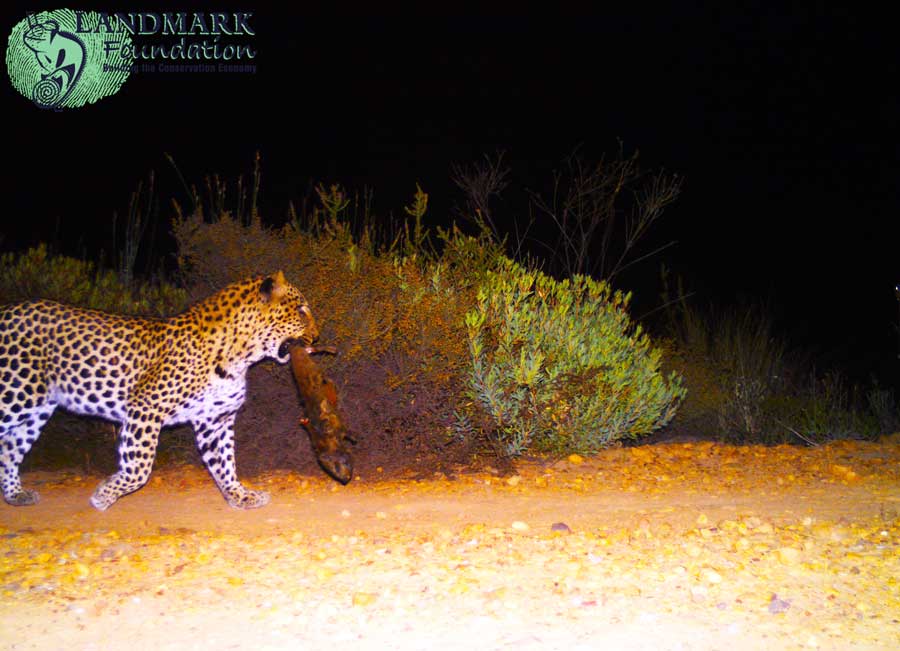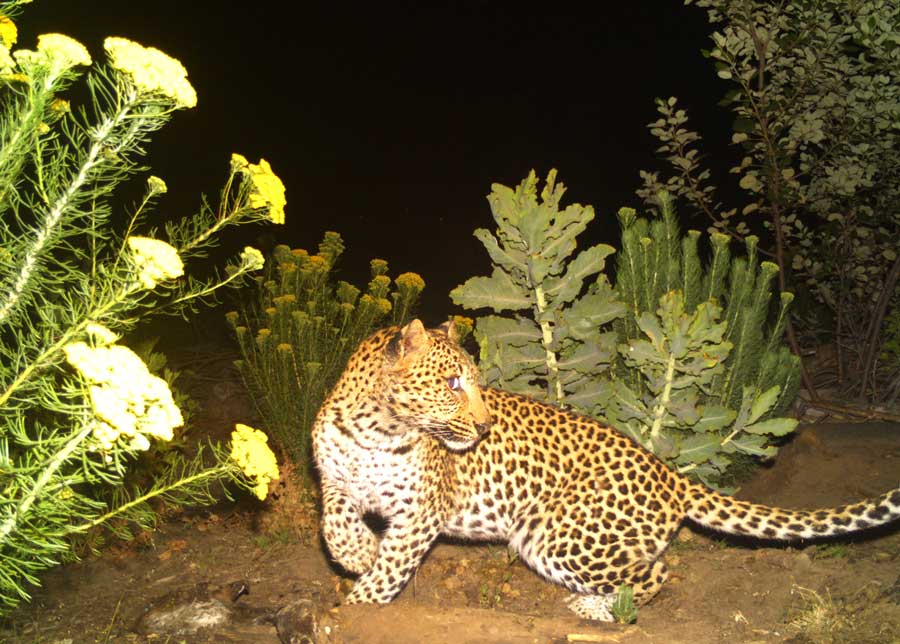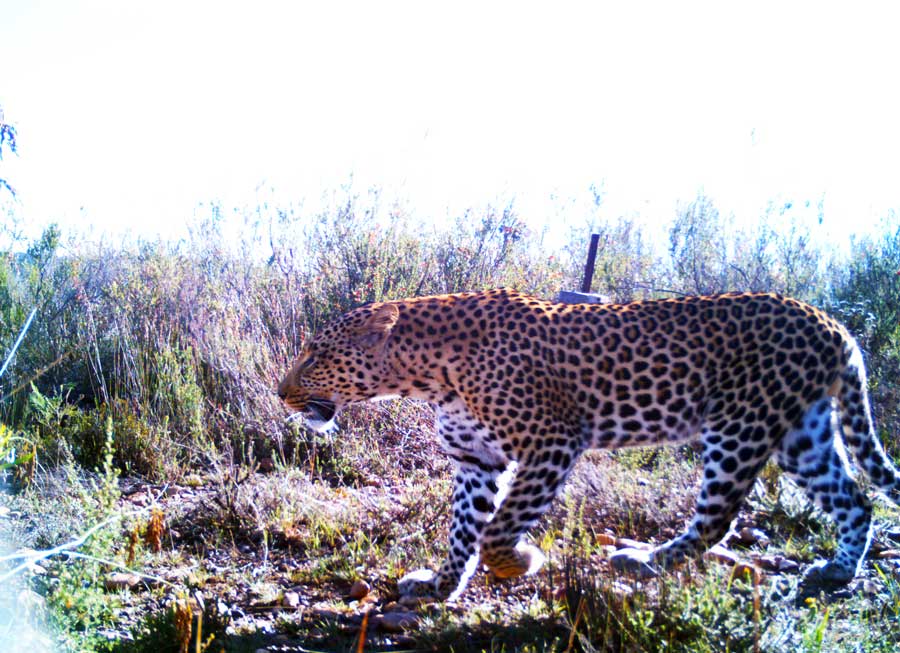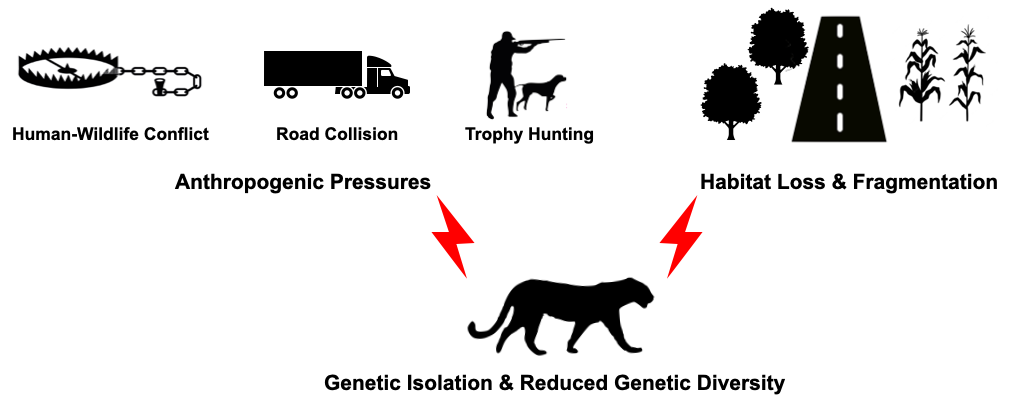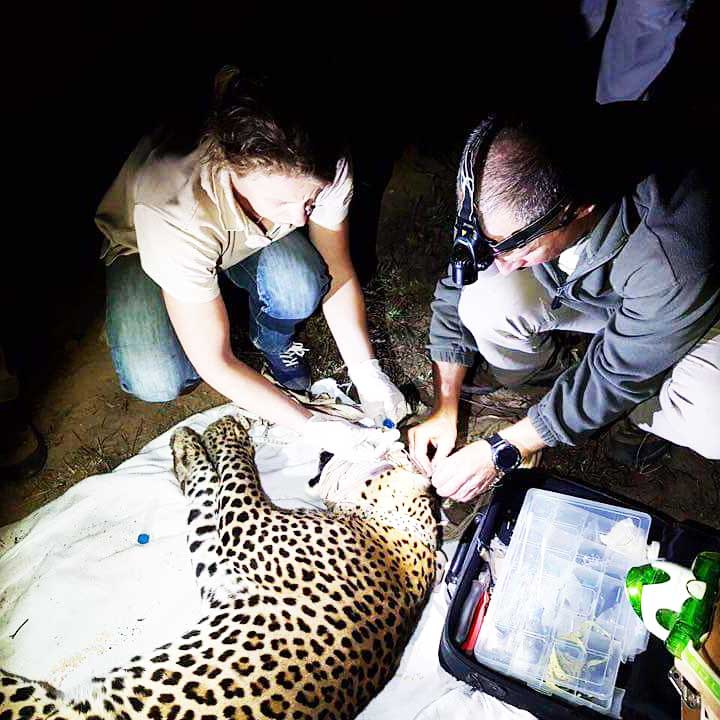
Leopard And Predator Project
Carnivore populations are critically important to maintaining healthy ecosystems. As top predators, the presence of large carnivores in an area has many important ecological consequences, such as the regulation of prey numbers, population control of mesopredators (such as jackal and caracal) through competition, and maintenance of a functional balance of biodiversity in the local community.
Examples of carnivores caught on our camera traps
When we started studying leopards (Panthera pardus) there was not much known about the species in the Eastern, Western or Northern Cape. Therefore, with a broad focus, we started by estimating their densities, understanding their activity patterns, and spatial requirements (their territories and social dynamics) in different land uses. As we learned more, our focus sharpened to pinpoint drivers of leopard resource selection, habitat prediction, threats, the genetic vigour and structure of leopard populations and delineate the physical corridors connecting leopard populations. This has contributed to our landscape ecology and management of leopards within and outside of protected areas and to the broader species management plan.
Why Leopards?
Leopards are considered vulnerable in the Southern African region, facing the risk of extinction in the medium term. When we started studying leopards (Panthera pardus), very little was known about the species in our focal area. Therefore, we started by estimating their densities, understanding their activity patterns, and spatial requirements in different land uses. As we learned more, our focus sharpened to pinpoint drivers of leopard resource selection, habitat prediction, threats, the genetic vigour and structure of leopard populations and delineate the physical corridors connecting leopard populations. Our scientific research has contributed to our landscape ecology and management of leopards (e.g., translocation) within and outside of protected areas and to the broader species management plan.
Since the project started, more than 70 leopards have been rescued from certain death, and 50 leopards have been intensively tracked using drop-off satellite collars making it one of the world’s largest, and longest-running leopard research projects globally.
Loss and fragmentation of habitat, and human-caused mortality are major threats to large carnivores including leopards.
What have we learned from leopards so far?
Leopard Density Estimates
Overall, leopard abundance is estimated between 175 (±98.7), and 588 (±168.8) in the Western Cape and between 365 (±93.2) and 429 (±139.9) in the Eastern Cape, respectively. However, available habitat predictions included fragmented habitat and small isolated islands of habitat that may be too small to host viable populations or have large edge effects. These factors are known to negatively affect populations, especially for wide-ranging felids such as leopards and should be considered in management planning. For example, from GPS collars, camera trap and DNA analysis the population densities in the respective areas may be isolated from one another. In the greater Baviaanskloof area (3500 km²/ 350 000 ha) there are merely 30 – 35 territorial leopards remaining, while in the fragmented patches of indigenous forest in the Garden Route (of 800 km²/ 80 000 ha) only 20 – 25 leopards remain. Therefore, ensuring these individuals can connect to one another is key to the species’ survival in the region.
Camera trapping is an ideal tool to estimate leopard population density as each individual as a unique fur pattern.
Leopard Spatial Requirements and Structure
Space use is a result on available resources. Where leopards occupy inhospitable, mountainous areas, with low prey availability, individuals require more space and tend to move further for resources and mates. As a result leopards sometimes move as far as 20km or more per day when hunting. In mountainous area in the Eastern and Western Cape, on average the males use 250 km² (25 000ha) while females use 120 km². However, one male utilized as much as 100 000ha and hosted three females within his range. Their large spatial requirements restrict their numbers in an area as they are density dependent. They are territorial and males allow some range overlap with neighbouring males (as long as they don’t interfere with their females), while females appear to have very strict boundaries not allowing any overlap with other females. Where resources are more easily available such as protected areas, and low HWC zones, leopards utilize smaller ranges. In the forests of the Garden Route, males are using 100 km² and females half of that – allowing two females to one male on average. A major problem for leopards in the forest, however, is the loss of habitat. In 1996, 2200km² of forest was available to leopards and other wildlife in the Garden Route, while today merely 800km² is available which has disastrous effects on not only the leopard population but biodiversity in general.
Leopard Habitat: Drivers and Predictions
Understanding how leopards interact with their environment tells us how to best conserve them. Leopards select areas with moderate slopes, areas with natural land-cover and plantations, ravines and rivers, and good prey availability. Leopards tend to avoid areas with high human activity, roads, and highly modified areas such as cultivated landscapes. Using variables such as human population density, distance to roads, rivers, land use zones and prey availability we were able to develop a map indicating where suitable leopard habitat exists. Understanding how leopards interact with their environment tells us how to best conserve them. Leopards select areas with:
- moderate slopes;
- natural land-cover and plantations, ravines and rivers;
- good prey availability;
- low human activity, roads, and highly modified areas (such as cultivated landscapes).
Using variables such as human population density, distance to roads, rivers, land use zones and prey availability we were able to develop a map indicating where suitable leopard habitat exists. But it’s not just the physical environment that makes leopard habitat, its counterparts, mates, and neighbours. We have found that while leopards are solitary and territorial, social cues are a major driver of how they use an area. Where their neighbours’ position themselves dictate how they use space. Where females place themselves are a major driver of how the population structures itself. These valuable insights would remain unknown without the valuable data obtained from collared leopards.
Map of predicted leopard habitat in the Eastern and Western Cape, South Africa. The warmer shades indicate high quality leopard habitat and cool shades indicate non-habitat. These are based on data obtained from collared leopards and how they interact with their environment.
Genetic vitality and structure
While African leopard populations are considered to be continuous as demonstrated by their high genetic variation, the southernmost leopard population’s structure of the Eastern and Western Cape (‘South population’), South Africa, may be affected by anthropogenic activities. Artificial and natural barriers reduce connectivity among populations resulting in low gene flow and isolation. The deleterious effects low gene flow has on small, isolated populations, affect their survival and genetic fitness. Based on DNA samples from leopards in the Eastern and Western Cape, three populations were identified in the region where moderate to low levels of gene flow were observed. This suggests that there are pinch points in connectivity between these populations.
Map of the three leopard subpopulations in the Eastern and Western Cape, based on DNA analyses.
A major concern is the ‘South population’ where density estimates and gene flow appeared to be low, and corridors seemed to be very limited to absent. To ensure these populations do not become genetically isolated, ensuring leopard connectivity and corridors, as well as reducing HWC and using translocations as a management tool under specific conditions are key conservation tools. We are currently running an extensive whole-DNA project incorporating leopard samples across the Eastern, Western and Northern Cape to determine larger-scale gene flow to intensify our investigation into leopard connectivity and conservation.
Leopard population connectivity and corridors
Natural landscapes are increasingly fragmented due to human activity. This contributes to isolation and inadequate gene flow among wildlife populations. Ensuring habitat connectivity despite transformed landscapes can mitigate these risks. Using leopard movement behaviour data, we delineated leopard corridors. Leopard corridors were characterised by mountainous areas with low human activity. Leopards avoid highly transformed landscapes such as cultivated fields and areas with low cover. These areas result in low connectivity, isolating some populations (See “Genetic vitality and structure”). Where corridors are not functional, active conservation measures for species connectivity becomes important, such as HWC mitigation and rewilding efforts.
Leopard translocations as a management tool
Translocation is a commonly employed non-lethal tool to mitigate HWC. However, it is rarely evaluated and there are conflicting reports of success, particularly for leopards. In efforts to better understand the nuances of translocation as a management tool, we assessed data from 60 translocation events obtained from various conservation entities from five South African provinces between 1994 and 2022. We found that in most cases translocations are not formalized and very little information is available on the outcomes due to lack of monitoring both pre and post translocation effort. In this study, we found that:
- 77% of the translocation events were undertaken due to high levels of HWC;
- longer translocation distance increase success and moving an individual to a different spot within its home range is not a translocation;
- damage-causing animals (DCA) can be successfully translocated;
- monitoring potential release sites is key to success and monitoring the translocated animal is of paramount importance.
Summary of distances leopards were translocated and the outcome of translocation. Standardizing translocation protocols
(See “Proposed Protocols of Leopard Translocations”) can contribute to managing DCA and inform conservation strategy that can restore vulnerable populations or re-establishing an extinct population within their historical range. Conservation entities should advocate alternative non-lethal practices to reduce human-carnivore conflicts. Moreover, formalizing data gathering prescripts and maintaining a rigorous, centralized database for all translocation events will contribute to evaluating the effectiveness of each event.
| PROPOSED PROTOCOLS OF LEOPARD TRANSLOCATIONS[UU4] |
| Conditions required for consideration for translocation of Damage Causing Leopards (DCA) |
| 1. Leopard causes validated, repeated, regular losses to livestock where several non-lethal mitigation actions have failed. 2. All mitigation measures proposed by conservation authorities have been exhausted. 3. Leopard causes validated, repeated and regular, and excessive losses to wild or domestic game specimens managed in breeding camps, which is inconsistent with the animal’s natural behavior and is ecologically or excessively commercially damaging in areas with Certificates of Adequate Enclosures for the species affected. 4. Leopard presents an imminent and realistic threat to human life. |
| Pre-conditions for translocation to be undertaken |
| 1. Ensuring release site is large enough to support leopards in a wild free-roaming territory. 2. Release site habitat has depleted presence or absent leopard activity, as is reasonably possible to determine or areas where such releases would be tolerated and provide opportunities for ecological dispersal 3. Encourage ecologically compatible release site habitat to the original capture site habitat. 4. Receiving habitat has adequate natural prey availability. 5. Release site is considered to have no or very low chance of post release human-carnivore conflict present. 6. Release site is not surrounded by intensive livestock farming. 7. Released leopards must be GPS satellite collared and monitored, and form part of a scientific analysis of the efficacy of such translocations. 8. Basic morphology, sex of the animal and reason for translocation should be collected. 9. Genetic analysis of all leopards will be undertaken to understand the genetics of local populations, and best available information must be consulted, i.e., ecotypes, subspecies. |
| Post-translocation objectives |
| 1. Leopards are not to be habituated or kept captive beyond the release period deemed appropriate by the conservation authorities and veterinarians caring for the animals. 2. Leopards must be GPS Satellite collared and monitored for as long as possible, but at least six months post-release, and form part of the scientific analysis of the efficacity of translocations. 3. Preferentially leopards are to be released into state/ or collaborating private protected areas where they had been extirpated. 4. Private landowners or entities receiving the translocated leopards must be encouraged to contribute towards the costs of translocation, collars and any costs incurred in monitoring or analysis of the translocation effort. 5. Private protected area entities receiving the leopards must enter a legal contract with the authorities to take all legal and financial responsibility for any damage that may result from the relocated animal. 6. Any subsequent interference with the leopard must be subject to relevant permitting. 7. The entities receiving the leopards will comply with all permit requirements and conditions. 8. Translocated leopards may not be hunted. 9. Entities that want to receive leopards may not canvas for leopards to be labelled as DCA, any such actions will disqualify applicants from participating in translocations. 10. Leopards will be randomly allocated to receiving entities by the authorities if competing private applications exist, but ecological considerations will more than likely be able to discriminate the most suitable release sites. 11. The authorities may elect to serially send opposite sexes sequentially to the same location should attempts be supported to re-establish leopards in former areas of distribution (i.e., reintroduction). |
Latest News
CONTACT US
Jeannine 0833243344
Bool 0845924099
E-Mail:
jeannine@landmarkfoundation.org.za
Find us on Facebook
Find us on Instagram
Follow us on X (Twitter)



